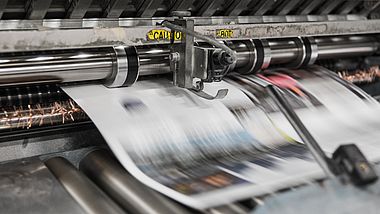Participating companies | Energiedienst AG and Evonik Operations GmbH |
Project location | Baden-Württemberg |
Industry | Energy/energy generation |
Technologies used | Utilisation of external waste heat for heating flats in Rheinfelden and for supplying hot water; Additional ORC plant for generating electricity from waste heat (in summer) |
Energy efficiency | Heating energy savings of approximately 20% in the town of Rheinfelden |
CO2 savings | 6,705 t CO2e/yr |
Investment | €5.1 million |
Payback period | More than 8 years |
Funding programmes | KfW (German Credit Institute for Reconstruction) Energy Efficiency Programme – Waste Heat Investment Grant 494 |
Evonik Operations GmbH, based in Rheinfelden, Germany, manufactures products such as pyrogenic silica and hydrogen peroxide for the food industry. The company generates a large amount of waste heat when cooling exothermic processes. Although the waste heat from several production plants was already being used for internal processes and to heat buildings on the factory premises, some of it remained unused. The waste heat can be used sustainably, nevertheless, for example, for heating and supplying hot water in neighbouring residential areas or for generating electricity. In 2020, Energiedienst AG created a local heating concept for using Evonik’s waste heat externally. The heat is used directly in residential and commercial buildings. As part of the process, 95-degree water is taken from the cooling circuit within Evonik’s production facilities. This water has been fed into the local heating grid in Grendelmatt since the end of 2020 and heats residential buildings there. Energiedienst takes a yearly thermal output of 5.2 MW. This is equivalent to 42 million kWh, which it uses to heat its own buildings and several thousand flats in Rheinfelden in order to provide them with hot water. Energiedienst AG laid around 900 metres of additional piping in order to tap the sources of the waste heat and connect them to Grendelmatt’s local heating grid. In the summer, the waste heat is used in an ORC plant to generate electricity when the demand for heating and hot water drops.
Transferability
The project has given concrete impetus to transferring the idea to other regions. The ‘Wärmeverbund Hochrhein’ feasibility study was started on the basis of this project. This study sees all of the industrial heat sources contrasted with the sinks in the municipalities. Further heat decoupling operations have already been planned in Rheinfelden as well. In principle, the project is transferable to a large number of municipalities that have existing local heating grids in the vicinity of companies that generate sufficient waste heat.
Energy Efficiency Award 2021
Pictures:
above: Evonik Industries AG
Graphic below: Energiedienst


![[Translate to English:] Produktionsstandort in Rheinfelden](/fileadmin/_processed_/a/5/csm_G__30__Energiedienst_AG_-_Evonik_Bild_oben_aaabb9ac84.jpg)
![[Translate to English:] Schaubild Wärmeversorgung](/fileadmin/_processed_/3/7/csm_G__30__Energiedienst_AG_-_Evonik_Bild_unten_dd33c79719.png)

